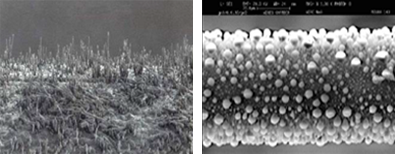Collaboration CERN - Task: Aging of the Mion Detector cell because it implies deposit accumulation, corrosion or cracking on cathodes and anodes
Development of radiation hard gaseous detectors able to withstand hadron fluences up to 1015 -1016 cm2 at the Large Hadron Collider (LHC) and at future very high luminosity colliders. Aging effects in wire chambers, a permanent degradation of operating characteristics under sustained irradiation, has been and still remains a main limitation to the use of gas detectors in high energy physics experiments.


The aging effects are the result of chemical reactions occurring in avalanche plasma near anodes in wire chambers leading to formation of deposits on electrode surfaces. Free-radical polymerization is regarded as the dominating mechanism of wire chamber aging, lead to the formation of deposits, conductive or insulating, on the electrode surfaces and manifest themselves as a decrease of the gas gain due to the modification of the electric field.


